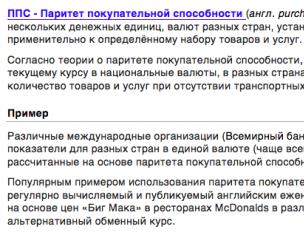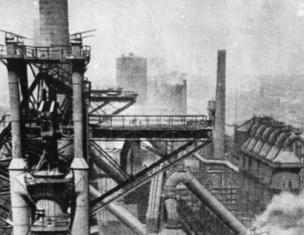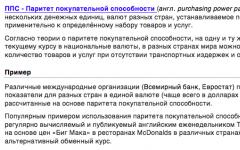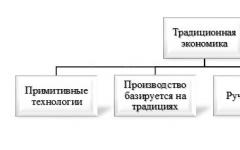Packing density is the fraction of the volume of the crystal lattice occupied by atoms.
The shortest distance between the centers of two balls in an elementary cell is equal to two ball radii - 2r. The volume of the ball is V = 4/3r 3 , the volume of the balls included in the elementary cell is V n = 4/3nr 3 , where n is the multiplicity of the elementary cell. If the unit cell volume is V 0 , then the packing density is P = (V n /V 0) 100%.
If the lattice period is a, then V 0 = a 3, the solution of the problem is reduced to expressing the atomic radius in terms of the lattice period, for a specific structure, the shortest interatomic distance should be determined, for example, in diamond 2r = a /4 (the shortest distance, equal to two atomic radii, is a quarter of the spatial diagonal of the cube).
In table. 2.3 shows the results of calculating the packing density for various structures.
Table 2.3
Packing density for various structures
|
Typegratings |
K. h. |
Atomic radiusr |
Cell multiplicityn | |
|
cubic primitive | ||||
As the coordination number increases, the packing density increases.
The filling of interstices in the fcc lattice, which corresponds to an increase in the unit cell multiplicity, leads to less dense packings.
2.8. Relationship between structure type, coordination number and electrical properties
The densest and densest packings (P = 68 - 74%) with c.h. 8/8 and 12/12 are typical for metals (bcc, fcc, hcp structures).
The least dense packings (P = 34% and similar) with c.ch. 4/4 (structures of diamond, sphalerite, wurtzite), 4/2 (cuprite), 2/2 (selenium) are typical for semiconductors.
Structures with intermediate c.h. 6/6 and density P 67%, for example, type NaCl, can have both conductive properties (TiO, TiN, VN, TiC, etc.), and semiconductor properties (PbS, PbSe, PbTe), and dielectric (NaCl, MgO, CaO, BaO).
Metallic substances can also crystallize into structures with low r.h., for example, in graphite r.h. equals 4, as in a diamond.
The most important semiconductors form the following structures:
diamond: Si, Ge, α-Sn;
sphalerite: ZnS, HgS, CdTe, AlP, AlAs, AlSb, GaP, GaAs, GaSb, InP, InAs, InSb, SiC, ZnSe, HgSe, ZnTe, HgTe;
cuprite: Cu 2 O, Ag 2 O;
fluorite: Mg 2 Si, Mg 2 Ge;
wurtzite: ZnS, ZnO, CdS, CdSe;
sodium chloride: PbS, PbSe, PbTe;
nickel arsenide: VS, VSe, FeS, FeSe.
2.9. Island, chain and layered structures
In addition to coordination structures, in which the interatomic distances between all structural units are the same (one type of bond), in island, chain and layered structures (Fig. 2.15) groups of atoms can be distinguished that form "islands" (molecules), continuously extending in one direction (chains), or infinite in two (layers) or three (frameworks) dimensions. Such structures are molecular.
On fig. 2.15 a shows island structures: 1 - linear, 2 - two-dimensional (square), 3 - three-dimensional (tetrahedron). On fig. 2.15 b chain structures are shown: 4 - linear, 5 - zigzag, 6 and 7 - links from octahedra and tetrahedra.

Fig.2.15. Island and chain structures
Control questions
Which lattice is called simple, complex?
How is a polycrystal different from a single crystal?
What does the entry mean: (hkl), (hkl),< hkl>, ?
What values can Miller indices take?
Write down the Miller indices of the planes perpendicular to the edges of the cube.
Write down the Miller indices of the planes perpendicular to the diagonals of the faces of the cube.
Write down the Miller indices of the planes parallel to the faces of the cube.
Write down the Miller indices of the directions perpendicular to the faces of the cube.
What is the difference between (110), (110 ),< 110>, ?
What phenomenon is called polymorphism?
What is isomorphism?
How is the structure of glass different from the structure of crystals?
What are the features of the structure of amorphous bodies?
What structures are close packings? How are the atoms arranged in them?
What is the difference between GPU and GCC?
What are the close-packed coordination numbers?
Where are the tetrahedral interstices located in the fcc lattice?
Where are the octahedral interstices located in the fcc lattice?
What is polytypism?
What is the unit cell multiplicity?
How do different types of cubic structures differ?
Draw the elementary cells of copper, silicon, NaCl, CsCl, sphalerite.
Explain the arrangement of atoms in the wurtzite lattice.
On the basis of what dense packing is the wurtzite lattice built?
On the basis of what dense packing is the sphalerite lattice built?
How many atoms are there in a wurtzite unit cell?
How is the packing density of crystal structures calculated?
Which crystal lattices have the highest packing density?
Which crystal lattices have the smallest packing density?
How is packing density related to coordination number?
Can chain structures be classified as coordination structures? Why?
What is the difference between long-range and short-range order in solids?
All metals in the solid state have a crystalline structure. Atoms in a solid metal are ordered and form crystal lattices (Fig. 1).
Rice. Fig. 1. Diagrams of crystal lattices: a – body-centered cubic; b - face-centered; c - hexagonal close-packed
Crystal cell represents the smallest volume of the crystal, which gives a complete picture of the atomic structure of the metal, and is called the unit cell.
Metals are characterized by crystal lattices of three types: cubic body-centered (bcc), in which atoms are located at the vertices of the unit cell and one in its center; face-centered cubic (fcc), in which atoms are located at the vertices of the unit cell and at the centers of its faces; hexagonal close-packed (hcp), which is a hexagonal prism in which atoms are arranged in three layers.
The properties of the material depend on the type of crystal lattice and the parameters that characterize it:
1) interatomic distance, measured in angstroms 1А°=10 -8 cm
2) packing density ( lattice basis is the number of particles per unit cell). Cubic simple - B1, bcc - B2, fcc - B4, hcp - B6.
3) coordination number(KN) - the maximum number of atoms equidistant and located at the nearest distance from the atom taken as a reference point. Cubic simple - KN=6, BCC - KN=8, FCC - KN=12, HPU - KN=12.

The material properties defined in the direction of the front plane and the diagonal plane are different - this phenomenon is called anisotropy, i.e. uneven properties in different directions. All metallic materials have this property. Amorphous bodies have the property isotropy, i.e. have the same properties in all directions.
Crystal lattices can have various structural imperfections that significantly change the properties of the material. A real single crystal always has a free (outer) surface, on which, already due to surface tension, the lattice is distorted.
Defects of the internal structure are divided into point, linear and planar.
Point defects include vacancies (when individual sites of the crystal lattice are not occupied by atoms); dislocated atoms (if individual atoms are in interstices) or impurity atoms, the number of which is very large even in pure metals. Near such defects, the lattice will be elastically distorted at a distance of one or two periods (Fig. 2a).

Rice. 2. Defects in the crystal lattice: a - point; b - linear; c - planar
Linear defects are small in two dimensions and quite large in the third. Such defects include the displacement of atomic planes or dislocations and chains of vacancies (Fig. 2b). The most important property of such defects is their mobility inside the crystal and active interaction with each other and with other defects.
A change in the crystal lattice of a material is possible under the influence of external factors, namely temperature and pressure. Some metals in the solid state in different temperature ranges acquire different crystal lattices, which always leads to a change in their physicochemical properties.
The existence of the same metal in several crystalline forms is called polymorphism. The temperature at which a change in the crystal lattice occurs is called the temperature of the polymorphic transformation. All heat treatment processes are based on this phenomenon. Polymorphic modifications are denoted by Greek letters (a, b, g and others, which are added as an index to the element symbol).

Most solids are crystal structure, in which the particles from which it is "built" are in a certain order, thereby creating crystal lattice. It is built from repeating identical structural units - elementary cells, which links with neighboring cells, forming additional nodes. As a result, there are 14 different crystal lattices.
Types of crystal lattices.
Depending on the particles that are at the lattice nodes, there are:
- metal crystal lattice;
- ionic crystal lattice;
- molecular crystal lattice;
- macromolecular (atomic) crystal lattice.
Metal bond in crystal lattices.
Ionic crystals have increased brittleness, tk. a shift in the crystal lattice (even a slight one) leads to the fact that like-charged ions begin to repel each other, and bonds break, cracks and splits form.
Molecular bonding of crystal lattices.
The main feature of the intermolecular bond is its "weakness" (van der Waals, hydrogen).

This is the texture of ice. Each water molecule is connected by hydrogen bonds with 4 molecules surrounding it, as a result, the structure has a tetrahedral character.
The hydrogen bond explains the high boiling point, melting point and low density;
Macromolecular bonding of crystal lattices.
Atoms are located at the nodes of the crystal lattice. These crystals are divided into 3 types:
- frame;
- chain;
- layered structures.
frame structure possesses diamond - one of the hardest substances in nature. The carbon atom forms 4 identical covalent bonds, which indicates the shape of a regular tetrahedron ( sp 3 - hybridization). Each atom has a lone pair of electrons that can also bond with neighboring atoms. As a result, a three-dimensional lattice is formed, in the nodes of which there are only carbon atoms.
A lot of energy is required to destroy such a structure, the melting point of such compounds is high (for diamond it is 3500°C).
Layered structures indicate the presence of covalent bonds within each layer and weak van der Waals bonds between the layers.
Consider an example: graphite. Each carbon atom is in sp 2 - hybridization. The 4th unpaired electron forms a van der Waals bond between the layers. Therefore, the 4th layer is very mobile:

The bonds are weak, so they are easy to break, which can be observed in a pencil - "writing property" - the 4th layer remains on paper.
Graphite is an excellent conductor of electric current (electrons are able to move along the plane of the layer).
chain structures have oxides (for example, SO 3 ), which crystallizes in the form of shiny needles, polymers, some amorphous substances, silicates (asbestos).
The study of metals in accordance with the Periodic Table of the Elements shows that, with the exception of Mn and Hg, the elements of subgroup A, including transition metals and most rare earth elements, as well as metals of subgroups IB and IIB and some elements of group IIIB, including Al, form one of the following typical metal structures:
A 1 - cubic face-centered lattice (fcc)
cubic face-centered lattice the following metals have: g - Fe, Al, Cu, Ni, a - Co, Pb, Ag, Au, Pt, etc.
In a cubic face-centered lattice, atoms are located at the vertices of the unit cell and at the centers of its faces (Fig. 1.5).
Each atom in this lattice is surrounded by 12 nearest neighbors located at equal distances equal to = 0.707×a, Where A- elementary cell edge. The number of nearest neighbors equal to 12 is called the coordination number of the crystal lattice. In addition to these nearest atoms, there are 6 atoms in the crystal lattice, distant at much greater distances, equal to A.
The considered crystal lattice has two types of voids (interstices, in which smaller atoms of other elements in alloys can be located) forming interstitial solid solutions.
The largest internodes or voids are in the center of the cube and in the middle of its edges. Each of these voids is surrounded by six atoms of the fcc lattice, occupying places at the vertices of a regular octahedron. In this regard, they are called octahedral voids (Figure 1.5, b). Such positions of various elements in the face-centered cubic lattice are occupied by Na and Cl atoms in the NaCl lattice. The same positions are occupied by carbon in the g-Fe lattice.
In addition to these voids in the fcc lattice, there are smaller voids, called tetrahedral, due to the fact that they are surrounded by 4 atoms. In total, there are 8 tetrahedral voids in the fcc lattice (Figure 1.5, V).
The dimensions of the tetrahedral and octahedral voids can be felt if we assume that the lattice is built of rigid balls, of radius r, in contact with each other; in this case, spheres with a radius of 0.41 r and 0.225 r, respectively, for octahedral and tetrahedral voids, could be placed in the existing gaps.
The most densely packed planes in the structure of a face-centered cube are the planes shown in the figure. Their symbol (111) (Figure 1.5., G).
body-centered cubic lattice And 2 (bcc) have metals a - Fe, chromium, tungsten, molybdenum, vanadium, sodium, lithium and others. Structure A 2 is less densely packed.
The atoms in the bcc lattice are located at the vertices and in the center of the unit cell (Figure 1.6).
Each atom in this cell has 8 nearest neighbors located at a distance of where, A is the length of the edge of the cube. Therefore, the coordination number of the lattice is 8. Sometimes it is denoted (8 + 6), because The next most distant atoms are located at a distance a, their number is 6.
There are also 2 types of voids in the bcc structure. Large ones occupy positions on the faces of the cube (Figure 1.6, V). They are surrounded by 4 atoms located at the vertices of the tetrahedron, the edges of which are pairwise equal. Smaller voids surrounded by 6 atoms occupying places at the vertices of an irregular octahedron are located in the middle of the edges and faces of the cell (Figure 1.6, G). If the bcc lattice structure is constructed from rigid balls, then spheres with a radius of 0.292 r can be placed in tetrahedral voids, and 0.154 r in octahedral voids.
Thus, the maximum size of a sphere that can be placed in the voids of a more densely packed fcc lattice turns out to be larger than in a bcc lattice.
The introduction of other atoms into the octahedral pore of the bcc lattice causes the displacement of two atoms in the direction parallel to the edge of the cube, which causes the lattice to expand in this direction. In the structure of martensite, where carbon atoms are introduced into octahedral voids located only on edges parallel to the C axis and in the centers of faces perpendicular to this axis, this leads to a tetragonal distortion of the a-Fe lattice.
The most densely packed bcc planes are 12 planes of the (110) family (Figure 1.6. b). In these planes, there are 2 directions in which the rigid balls can touch.
Hexagonal close-packed lattice A 3 (hcp) is possessed by metals such as Zn, b - Co, Cd, Mg, a - Ti, a - Zr.
The hexagonal sieve is built from separate layers, and in such a way that each atom of any layer is surrounded by 6 neighbors located at equal distances belonging to the same layer, and, in addition, it has three nearest neighbors in layers located above and below this layer (Figure 1.7).
The distance between atoms in hexagonal layers is denoted by A, cell height in s. Six nearest neighbors located in adjacent layers will also be at a distance, and from this atom, if the ratio of the axes s/a is, then such a structure is called an ideal close-packed structure. Moreover, the coordination number in this case, as well as in the fcc lattice, is 12.
Most metals with a hexagonal close-packed lattice have an axis ratio s/a= 1.56 - 1.63. The exceptions are Zn and Cd (1.86; 1.89). This is due to the fact that the electron clouds of Zn and Cd atoms do not have spherical symmetry and are elongated along the C axis. In the hexagonal close-packed lattice, as well as in the fcc, there are 2 types of voids: octahedral and tetrahedral (Figure 1.7, b).
The diameters of hard spheres that can be placed in these voids are 0.41 r and 0.225 r, as well as for fcc.
It is enough to look at the construction of close-packed planes of the fcc lattice (111) (Figure 1.8, A) to find a complete analogy in the construction of atoms in these two lattices. The difference between these gratings is the alternation of layers. If in the hexagonal lattice there is an alternation of layers ABAB, etc., then in the fcc lattice: ABCABC (Figure 1.8, b), i.e. this uses the third possible position of the close-packed layer.
The difference in the energy ratio between these two lattices is insignificant and, in connection with this, the sequence of alternating layers can easily be disturbed during plastic deformation, as well as as a result of the appearance of crystal defects during its growth, the so-called stacking faults.
Thus, the apparent difference in the construction of the hcp and fcc lattices is not at all large (Figure 1.8).
Carbon in the form of diamond, silicon, germanium, a - tin (gray) have a double cubic grating type diamond(Figure 1.9). It differs from the fcc lattice by the presence of four additional atoms in four of the eight tetrahedral voids. As a result, the structure is looser.
Each diamond atom is surrounded by only four nearest neighbors located at the corners of a regular tetrahedron. The coordination number of such a structure is 4.
As shown above, the same metals at different temperatures can have different crystal structures, which is caused by their allotropy.
An allotropic (polymorphic) transformation is a change in the spatial lattice of a crystalline body.
As examples of allotropic transformations, one can cite the transformation of the low-temperature allotropic form a - Fe with a body-centered cubic lattice into the high-temperature form g - Fe with a face-centered cubic lattice at a temperature of 910 ° C and the subsequent transformation at a temperature of 1392 ° C g - Fe into d - Fe with a body-centered cubic lattice similar to a - Fe. Similar transformations can be observed in titanium, zirconium, etc. In titanium and zirconium, the low-temperature allotropic form is a - Ti, a - Zr with a hexagonal close-packed lattice. At temperatures above 882°C for titanium and 862°C for zirconium, b-Ti and b-Zr are formed, which have a body-centered lattice.
As you have seen, allotropic transformation is that the atomic structure of a crystalline body changes when heated and cooled. The very process of rearrangement of the crystal lattice occurs isothermally at a constant temperature, the cooling curve of the alloy undergoing allotropic transformations is similar to the curve observed during the solidification of liquid metal. The transition temperature is called the critical point of transformation. At a temperature (T 0) a phase equilibrium of two allotropic varieties is observed.
Similarly to the process of crystallization, allotropic transformation occurs with the absorption of heat during heating and its release during cooling. Allotropic transformation (also by analogy with the crystallization process) occurs through the formation of nuclei and their subsequent growth, and therefore it always proceeds with the presence of supercooling (during cooling) and overheating when heated.
Allotropic transformation occurs, as well as the process of crystallization, in connection with the desire of the system to reduce free energy.
One of the most common materials that people have always preferred to work with was metal. In each era, preference was given to different types of these amazing substances. So, IV-III millennia BC are considered to be the age of Chalcolith, or copper. Later it is replaced by bronze, and then the one that is still relevant today - iron comes into force.
Today it is generally difficult to imagine that it was once possible to do without metal products, because almost everything, from household items, medical instruments and ending with heavy and light equipment, consists of this material or includes separate parts from it. Why did metals manage to gain such popularity? What are the features and how it is inherent in their structure, let's try to figure it out further.
General concept of metals
"Chemistry. Grade 9" is a textbook used by schoolchildren. It is in it that metals are studied in detail. Consideration of their physical and chemical properties is devoted to a large chapter, because their diversity is extremely large.
It is from this age that it is recommended to give children an idea of \u200b\u200bthese atoms and their properties, because adolescents can already fully appreciate the value of such knowledge. They perfectly see that the variety of objects, machines and other things that surround them is based on just a metallic nature.
What is a metal? From the point of view of chemistry, it is customary to refer to these atoms those that have:
- small at the external level;
- exhibit strong restorative properties;
- have a large atomic radius;
- how simple substances have a number of specific physical properties.
The basis of knowledge about these substances can be obtained by considering the atomic-crystalline structure of metals. It explains all the features and properties of these compounds.
In the periodic system, most of the entire table is allocated for metals, because they form all secondary subgroups and the main ones from the first to the third group. Therefore, their numerical superiority is obvious. The most common are:
- calcium;
- sodium;
- titanium;
- iron;
- magnesium;
- aluminum;
- potassium.
All metals have a number of properties that allow them to be combined into one large group of substances. In turn, these properties are explained precisely by the crystalline structure of metals.

Metal properties
The specific properties of the substances under consideration include the following.
- Metallic sheen. All representatives of simple substances possess it, and most of them are the same. Only some (gold, copper, alloys) differ.
- Malleability and plasticity - the ability to deform and recover quite easily. In different representatives it is expressed to a different extent.
- Electrical and thermal conductivity is one of the main properties that determines the scope of the metal and its alloys.
The crystalline structure of metals and alloys explains the reason for each of the indicated properties and speaks of their severity in each specific representative. If you know the features of such a structure, then you can influence the properties of the sample and adjust it to the desired parameters, which people have been doing for many decades.

Atomic-crystalline structure of metals
What is such a structure, what is it characterized by? The name itself suggests that all metals are crystals in the solid state, that is, under normal conditions (except for mercury, which is a liquid). What is a crystal?
This is a conventional graphic image constructed by crossing imaginary lines through the atoms that line up the body. In other words, every metal is made up of atoms. They are located in it not randomly, but very regularly and consistently. So, if you mentally combine all these particles into one structure, you will get a beautiful image in the form of a regular geometric body of any shape.
This is called the crystal lattice of the metal. It is very complex and spatially voluminous, therefore, for simplicity, not all of it is shown, but only a part, an elementary cell. The set of such cells, brought together and reflected in and forms crystal lattices. Chemistry, physics and metal science are sciences that study the structural features of such structures.

Sama is a set of atoms that are located at a certain distance from each other and coordinate a strictly fixed number of other particles around them. It is characterized by the packing density, the distance between the constituent structures, and the coordination number. In general, all these parameters are a characteristic of the entire crystal, and therefore reflect the properties exhibited by the metal.
There are several varieties. They are all united by one feature - there are atoms in the nodes, and inside there is a cloud of electron gas, which is formed by the free movement of electrons inside the crystal.
Types of crystal lattices
Fourteen options for the structure of the lattice are usually combined into three main types. They are the following:
- Body-centered cubic.
- Hexagonal close-packed.
- Face-centered cubic.
The crystal structure of metals was studied only when it became possible to obtain large magnifications of images. And the classification of the types of lattices was first introduced by the French scientist Bravais, by whose name they are sometimes called.

Body Centered Lattice
The structure of the crystal lattice of metals of this type is the following structure. This is a cube, at the nodes of which there are eight atoms. Another one is located in the center of the free internal space of the cell, which explains the name "body-centered".
This is one of the variants of the simplest structure of the elementary cell, and hence the entire lattice as a whole. The following metals are of this type:
- molybdenum;
- vanadium;
- chromium;
- manganese;
- alpha iron;
- beta iron and others.
The main properties of such representatives are a high degree of malleability and plasticity, hardness and strength.
face centered lattice
The crystal structure of metals having a face-centered cubic lattice is the following structure. This is a cube, which includes fourteen atoms. Eight of them form lattice nodes, and six more are located one on each face.
They have a similar structure:
- aluminum;
- nickel;
- lead;
- gamma iron;
- copper.
The main distinguishing properties are gloss of different colors, lightness, strength, malleability, increased resistance to corrosion.

Hexagonal lattice
The crystal structure of metals with lattices is as follows. The elementary cell is based on a hexagonal prism. There are 12 atoms in its nodes, two more at the bases and three atoms freely lie inside the space in the center of the structure. Only seventeen atoms.
Metals such as:
- alpha titanium;
- magnesium;
- alpha cobalt;
- zinc.
The main properties are a high degree of strength, a strong silvery sheen.
Defects in the crystal structure of metals
However, all considered types of cells can also have natural flaws, or so-called defects. This may be due to various reasons: foreign atoms and impurities in metals, external influences, and so on.
Therefore, there is a classification that reflects the defects that crystal lattices can have. Chemistry as a science studies each of them in order to identify the cause and remedy so that the properties of the material are not changed. So, the defects are as follows.
- Point. They come in three main types: vacancies, impurities, or dislocated atoms. They lead to a deterioration in the magnetic properties of the metal, its electrical and thermal conductivity.
- Linear, or dislocation. Allocate marginal and screw. Deteriorate the strength and quality of the material.
- surface defects. They affect the appearance and structure of metals.
At present, methods have been developed for eliminating defects and obtaining pure crystals. However, it is not possible to completely eradicate them; the ideal crystal lattice does not exist.

The value of knowledge about the crystal structure of metals
From the above material, it is obvious that knowledge of the fine structure and structure makes it possible to predict the properties of the material and influence them. And this allows you to do the science of chemistry. The 9th grade of a general education school focuses on teaching students a clear understanding of the importance of the fundamental logical chain: composition - structure - properties - application.
Information about the crystal structure of metals very clearly illustrates and allows the teacher to clearly explain and show children how important it is to know the fine structure in order to correctly and competently use all properties.








